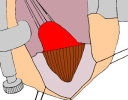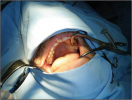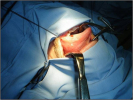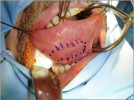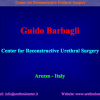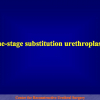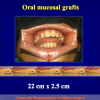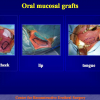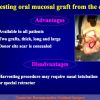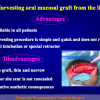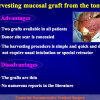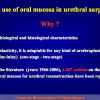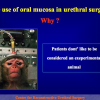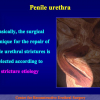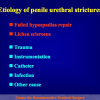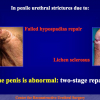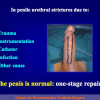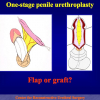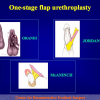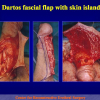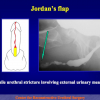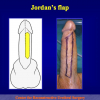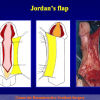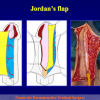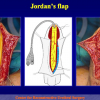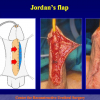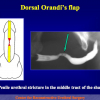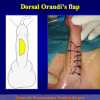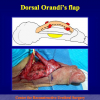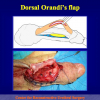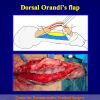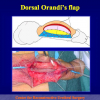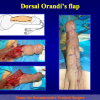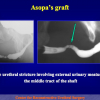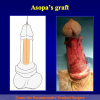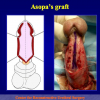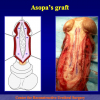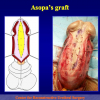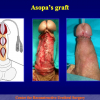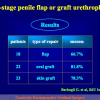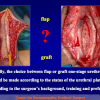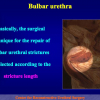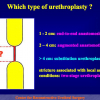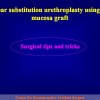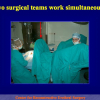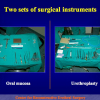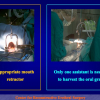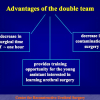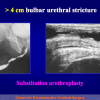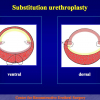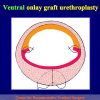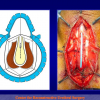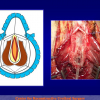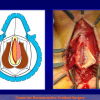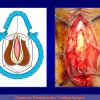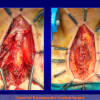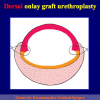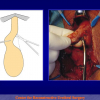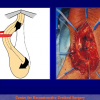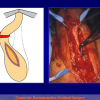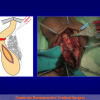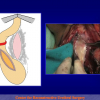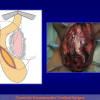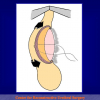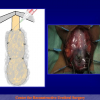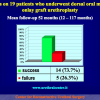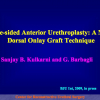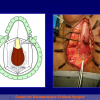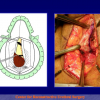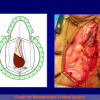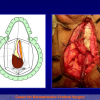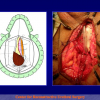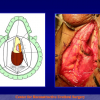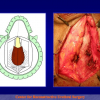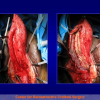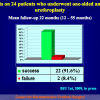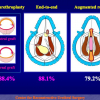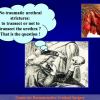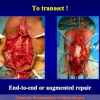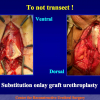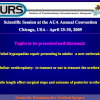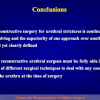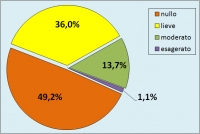- Prelievo di mucosa dalla guancia. In questa procedura la mucosa viene prelevata dalla faccia interna della guancia (figure 1,2,3,4). Questo tipo di prelievo rappresenta la procedura più frequentemente utilizzata nel nostro Centro.
- Prelievo di mucosa dalla lingua. In questa procedura la mucosa viene prelevata dalla faccia ventrale della lingua (figure 5,6,7,8,9). Questa procedura rappresenta un’ alternativa quando non è possibile, per vari motivi, effettuare il prelievo dalla guancia.
L’intervento chirurgico denominato “prelievo di mucosa dalla cavità orale” è indicato fondamentalmente nel seguente caso:
- pazienti con stenosi dell’uretra peniena e bulbare nei quali è indicata una ricostruzione, in uno o due tempi, del canale uretrale con trapianto di tessuto autologo.
In genere un solo prelievo è sufficiente per la ricostruzione dell’uretra. Tuttavia, in alcuni casi, si può rendere necessario prelevare un duplice prelievo (figura 10). Il prelievo di mucosa orale dalla guancia o dalla lingua è ben tollerato dal paziente e privo di complicazioni intra o post-operatorie o di sequele negative a distanza come da noi documentato con un apposito questionario, somministrato a 350 pazienti (vedi questionario)
|
Figura 1 |
Figura 2 |
Figura 3 |
Figura 4 |
Figura 5 |
|
Figura 6 |
Figura 7 |
Figura 8 |
Figura 9 |
Figura 10 |
| Urethral stricture surgery – tips and tricks. Surgery of the bulbar urethra Joint Meeting of the ESAU and the ESGURS October 25 – 27, 2007 Madrid – Spain |
 scarica PDF scarica PDF |
|
|
|
||
|
Lettura n° 2: Evaluation of early, late complications and patient satisfaction in 300 patients who underwent oral graft harvesting from a single cheek using a standard technique in a referral center experience AUA 2009 Chicago, Illinois – USA April 25 – 30, 2009 |
 scarica PDF scarica PDF |
|
|
|
||
| Lettura n° 3: One-stage substitution urethroplasty 24th Annual EAU Congress Stockholm – Sweden March 17 – 21, 2009 |
 scarica PDF scarica PDF |
|
|
|
||
| Lettura n° 4: The Use of Oral Mucosa for Anterior Urethroplasty Training Course on “Techniques in Reconstructive Urology” Mansoura – Egypy January 23 – 29, 2010 |
 scarica PDF scarica PDF |
Guido Barbagli, Michele De Angelis, Giuseppe Romano, Pier Guido Ciabatti, Massimo Lazzeri,
The Use of Lingual Mucosal Graft in Adult Anterior Urethroplasty: Surgical Steps and Short-Term Outcome
Eur Urol 2008; 54:671 – 676
Articolo n° 2
Lu-Jie Song; Yue-Min Xu; Massimo Lazzeri; Guido Barbagli
Lingual mucosal grafts for anterior urethroplasty: a review
BJU International, 2009: 104, 1052-1056
Articolo n° 3
Barbagli G, Vallasciani S, Romano G, Fabbri F, Guazzoni G, Lazzeri M.
Morbidity of Oral Mucosa Graft Harvesting from a Single Cheek
Eur Urol, 2010: 58, 33 – 41
Articolo n° 4
Guido Barbagli , Salvatore Sansalone , Giuseppe Romano and Massimo Lazzeri
Ventral onlay oral mucosal graft bulbar urethroplasty
BJU Int 2011; 108: 1218-1231
Articolo n° 5
Guido Barbagli, Salvatore Sansalone, Massimo Lazzeri
Oral Mucosa and Urethroplasty: It’s Time to Change
EUROPEAN UROLOGY 6 2 ( 2 0 1 2 ) 1 0 7 1 – 1 0 7 5
Risposta: L’intervento chirurgico può essere effettuato in regime di convenzione con il Sistema Sanitario Nazionale, senza alcuna spesa per il paziente.
2. Domanda: Per questo tipo di intervento quale tipo di anestesia è previsto?
Risposta: Anestesia generale con intubazione nasale.
3. Domanda: Quante ore dura l’intervento?
Risposta: Il prelievo di mucosa orale dalla guancia dura circa ½ ora.
4. Domanda: Ci sono rischi per la masticazione, la salivazione e la fisionomia del volto, dopo il prelievo di mucosa?
Risposta: No
5. Domanda: Quanti sono i giorni di degenza in ospedale previsti per questo intervento?
Risposta: In genere il ricovero ospedaliero, per l’uretroplastica con mucosa orale/linguale, varia da 5 a 7 giorni.
6. Domanda: Il prelievo di mucosa orale/linguale è doloroso?
Risposta: No. Solo il 3.7% ha richiesto l’uso di farmaci antidolorifici.
7. Domanda: Dopo quanti giorni dal prelievo posso iniziare a mangiare?
Risposta: Il primo giorno dopo l’intervento è consumata una dieta liquida. Dal secondo giorno dopo l’intervento è consumata una dieta anche solida.
8. Domanda: Quali particolari limitazioni nel cibo sono suggerite durante la convalescenza?
Risposta: Sono da evitare cibi particolarmente caldi.
9. Domanda: Quanto tempo dopo l’intervento potrò riprendere a mangiare normalmente?
Risposta: La maggior parte dei pazienti riprende completamente le proprie abitudini alimentari dopo un mese.
10. Domanda: Dopo l’intervento posso avere problemi ad aprire la bocca od a ridere? Dopo l’intervento posso avere problemi ad usare la lingua?
Risposta: No.
QUESTIONARIO TELEFONICO SULLE COMPLICAZIONI DOPO PRELIEVO DI MUCOSA ORALE DALLA GUANCIA.
Risultati su 350 pazienti
Barbagli G. et al, Eur Urol, 2010: 58,33 – 41
IMMEDIATO POST – OPERATORIO
1. Nei tre giorni successivi all’intervento ha avuto un sanguinamento fastidioso in bocca?
| Si 4.3% No 95.7% |
2. Nei tre giori successivi all’intervento il dolore alla guancia è stato di intensità:
| Nullo 49.2% Lieve 36% Moderato 13.7% Esagerato 1.1% |
3. Nei tre giorni successivi all’intervento il gonfiore alla guancia è stato di intensità:
| Nullo 33.7% Lieve 41.2% Moderato 24.6% Esagerato 0.5% |
4. Quanti giorni dopo l’intervento ha ripreso a mangiare normalmente (cioè cibi solidi)?
| Dopo 3 giorni 58.6% Dopo 6 giorni 31.4% Dopo 10 giorni 10% |
5. Nei due giorni successivi all’intervento ha dato più fastidio-dolore:
| La ferita alla bocca 27.7% L’intervento sull’uretra 52.6% Entrambi 1.4% Nessuna delle due 18.3% |
6. Nei tre giorni successivi all’intervento ha chiesto l’uso di antidolorifici per il dolore alla bocca?
| SI 3.7% No 96.3% |
RITARDATO POST – OPERATORIO
1. Il fastidio relativo alla ferita della bocca è durato:
| 1 settimana 73.4% 1 mese 22.9% 3 mesi 3.7% |
2. Il fastidio dei fili di sutura in bocca è stato:
| Nullo 48% Lieve 40.3% Moderato 10.9% Esagerato 0.8% |
3. Il fastidio dei fili di sutura in bocca è durato:
| 1 mese 93.9% 2 mesi 4.4% 3 mesi 1.7% |
4. A distanza da mesi dall’intervento, la cicatrice della ferita in bocca dà un fastidio:
| Nullo 82.8% Lieve 14.6% Moderato 2.6% Esagerato 0% |
5. Si sono verificate infezioni in bocca?
| SI 1.7% No 98.3% |
6. A distanza da mesi dall’intervento nota:
| Alterazione della sensibilità in bocca 2.3% Fastidio in bocca 10.3% Dolore in bocca 0% Nessun problema 87.4% |
7. A distanza di mesi dall’intervento nota una difficoltà ad aprire bene la bocca?
| Nullo 98.3% Lieve 1.4% Moderato 0.3% Esagerato 0% |
8. A distanza di mesi dall’intervento nota difficoltà a ridere?
| Nullo 99.7% Lieve 0.3% Moderato 0% Esagerato 0% |
9. A distanza da mesi dall’intervento nota di avere la bocca secca?
| Nullo 97.1% Lieve 2.6% Moderato 0.3% Esagerato 0% |
10. A distanza da mesi dall’intervento nota un gonfiore della guancia dopo i pasti?
| Nullo 98.3% Lieve 1.7% Moderato 0% Esagerato 0% |
11. E’ tornato a mangiare normalmente, come prima dell’intervento?
| Si 100% No 0% |
12. Quanto tempo è passato prima di ritornare a mangiare normalmente senza fastidio?
| 1 mese 94% 2 mesi 4.3% 3 mesi 1.7% |
13. Se potesse ritornare indietro nel tempo, rifarebbe l’intervento con il prelievo di mucosa buccale?
| Si 98% No 2% |
 scarica PDF |
Prelievo di mucosa orale dalla guancia:
|
 scarica PDF |
Prelievo di mucosa dalla lingua:
|


